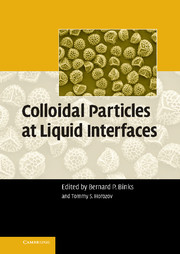Book contents
- Frontmatter
- Contents
- Preface
- List of Contributors
- 1 Colloidal Particles at Liquid Interfaces: An Introduction
- Section 1 Particles at Planar Liquid Interfaces
- Section 2 Particles at Curved Liquid Interfaces
- 5 Particle-Laden Interfaces: Rheology, Coalescence, Adhesion and Buckling
- 6 Solids-Stabilized Emulsions: A Review
- 7 Novel Materials Derived from Particles Assembled on Liquid Surfaces
- 8 Interfacial Particles in Food Emulsions and Foams
- 9 Collection and Attachment of Particles by Air Bubbles in Froth Flotation
- 10 Antifoam Effects of Solid Particles, Oil Drops and Oil—Solid Compounds in Aqueous Foams
- 11 Metal Foams: Towards High-Temperature Colloid Chemistry
- Index
5 - Particle-Laden Interfaces: Rheology, Coalescence, Adhesion and Buckling
Published online by Cambridge University Press: 11 October 2009
- Frontmatter
- Contents
- Preface
- List of Contributors
- 1 Colloidal Particles at Liquid Interfaces: An Introduction
- Section 1 Particles at Planar Liquid Interfaces
- Section 2 Particles at Curved Liquid Interfaces
- 5 Particle-Laden Interfaces: Rheology, Coalescence, Adhesion and Buckling
- 6 Solids-Stabilized Emulsions: A Review
- 7 Novel Materials Derived from Particles Assembled on Liquid Surfaces
- 8 Interfacial Particles in Food Emulsions and Foams
- 9 Collection and Attachment of Particles by Air Bubbles in Froth Flotation
- 10 Antifoam Effects of Solid Particles, Oil Drops and Oil—Solid Compounds in Aqueous Foams
- 11 Metal Foams: Towards High-Temperature Colloid Chemistry
- Index
Summary
Introduction
Particulate additives are found in the formulations of a great many high-surface area products in the form of emulsions and foams. Their presence is normally desirable for the purposes of stability. In the case of ice cream foams, tiny fat globules can attach themselves to the surfaces of the air pockets and hinder the process of coarsening by Ostwald ripening. In this case, the particles are a natural ingredient. In other instances, colloidal particles are deliberately added and Pickering emulsions are an important example. The occurrence of particles leading to stabilization can also be unwelcome, as in the case of emulsions formed when seawater and crude oils vigorously mix. This environmental problem can lead to very stable emulsions as a result of particles formed by asphaltenes or clay collecting at the oil–water interface.
The presence of particles at a fluid–fluid interface leads to numerous, profound consequences. Since a very large amount of energy is normally required to remove a particle from an interface (see Chapter 1 for a detailed explanation of this point), particles in these monolayers are normally irreversibly attached. Furthermore, as described in Chapter 2, these systems can be modified by exquisite tuning of interparticle forces, particle chemistry and particle size to create a wide range of morphologies of these “2-D suspensions”.
- Type
- Chapter
- Information
- Colloidal Particles at Liquid Interfaces , pp. 169 - 185Publisher: Cambridge University PressPrint publication year: 2006
- 3
- Cited by



